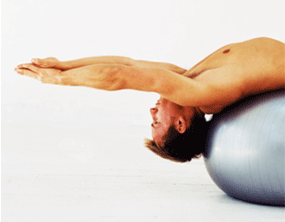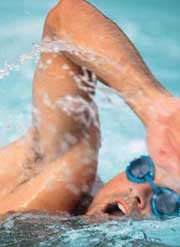Subtle or gross changes in the physiology of an athlete's body can have tremendous impact on the time and effort required to perform an activity. Difficult training regimes, repetitive motions (swimming, running, cycling), and overworkded muscles all place a great deal of stress on an athlete's body.
Repetitive motion, constant tension, and pressure often result in inflammation and swelling of soft tissue. The body responds to this inflammation by laying down scar tissue (cross fibers across the tissue) in an attempt to stabilize the affected area. This scar tissue: restricts motion, reduces circulation, inhibits nerve function, causes ongoing friction and pressure, and results in the production of yet more cross fibers and adhesions across inflamed soft tissues.
Techniques
The combination of chiropractic care with the Active Release Technique (ART) helps to increase an athlete's performance. Freeing up fixed joints and removing scar tissue from muscles and connective tissue increases flexibility and circulation throughout the body. The increased flexibility helps athletes prevent injuries, increase recovery times (from injuries and training), and allows the body to operate more efficiently. This treatment takes 20-30 minutes depending upon the amount of adhesions and tissues (muscles and tendons) involved. We address not only those areas related to your activity, but also those that could be compensating as a result. These techniques have become one of the most sought after soft-tissue treatments in the world today.
It is often your best bet in resolving a chronic soft tissue injury. It is used by industry professionals suffering from cumulative injury, as well as athletes who have suffered from a sports related injury. These soft tissue technqiues have contributed to olympic gold medals, ironman championships, amateurs who want to complete a race, and the weekend warriors who need to be healthy and active due to their busy schedules.
Areas that we commonly treat for performance care include:
- plantar fascia
- achilles tendon
- carpal tunnel syndrome
- frozen shoulder/adhesive capsultits
- golfers/tennis elbow (tendonitis)
- headaches/neck pain
- ilio tibial band syndrome (ITB)
- running injuries
- sciatica
- shin splints
- throwing injuries
- TMJ
Causes of Knee Pain in Cycling
Local cycling stores are an excellent source for the proper fitting of your bike. They can make custom changes and recommendations for any alterations that need to be done in the prevention of cycling injuries. If problems persist, seek professional, medical help to limit its severity and keep you active! At Fall Creek Chiropractic, you will be provided with excellent care and attention to your symptoms and also the activity that could be the cause of your problem. Following is a list of the things that could be contributing to your complaint of knee pain while cycling.
- Saddle to high - Knee extension that irritates the ITB, hips stressed by rocking while pedaling, location is usually in the back of the knee. It is usually a sign of patellofemoral loading.
- Saddle to low - Stress on patellar and quadriceps tendons
- Saddle to far forward - Stress on front portion of knee from pedaling in hyperflexed position
- Saddle to far back - ITB stretch from excessive forward reach for pedal, stress on hamstring tendon
- Crank arms too long - increased forces on the entire knee; patellar tendon and quad. tendon most affected
- Internally rotated cleats - patellar tendinosis, stress on the front of the knee
- Externally rotated cleats - inside knee stress
- Excessive hill work - chondromalacia, cartilaginous breakdown
- Pushing high gear ration - inside knee stress
- Hill running (on foot) - inside knee stress (uphill), tight quads (down)
- Deep leg squats - increased stress on entire knee
- Leg Length discrepancy - ITB stretch on shorter leg, back knee stress
- Wide position of pelvis - outside knee stress (increased Q angle)
- Pronated / Flat feet - inside knee pain
- Internal lower leg rotation - patellar malalignment
- Muscle weakness of quads, hams, hip flexors, gluteus muscle - alterations in pedaling technique that transfer stress to other parts of the body
- Leg inflexibility - ITB (Iliotibial band) syndrome
Inspiratory Muscle Training and Endurance Sport Performance
At Fall Creek Chiropractic we always want to stay abreast of interesting and beneficial information. Recently published in Science Daily a study from Indiana University found that strengthening inspiratory muscles (diaphragm and accessory muscles) by doing daily breathing exercises for six weeks significantly reduced the amount of oxygen these same breathing muscles required during exercise, possibly making more oxygen available for other muscles. At interesting fact was stated by Louise Turner, a researcher in the department of Kinesiology, said just the act of breathing during an endurance activity, such as running, cycling, and swimming performed at maximum intensity, can account for 10-15 percent of an athlete's total oxygen consumption. In the study they utilize a device to train inspiratory muscles. As resistance was set and done on a daily basis for 6 weeks of time the inspiratory muscles required less oxygen during the exercise. How can we apply this for at home care when we don't have a device to provide resistance. There are a few things here at Fall Creek Chiropractic that we can recommend. The ability to gain maximum oxygen intake is obtained when your posture is correct. When we slouch forward we compress the diaphragm region and automatically reduce our ability for maximu oxygen intake. In addition, our bodies have adapted to a poor postural postion due to our sedentary lives and work related positions (sitting with our shoulders rolled forward). This also minimized our ability to get maximum intake for the body to perform at its best for performance related activities. So, the ovbious, has to be recommended not only during our daily activities but also during exercise. While running and cycling be aware of your posture and make this position a comfotable spot and obtain more oxygen and further studies are being done to determine if this saved oxygen from inspiratory muscles is being transferred to other muscles, such as your legs. In addition, studies have shown that mid back chiropractic manipulations benefit the ability for the chest to expand and as a result take in more oxygen with less restrictions while breathing. Come in and discuss this with Dr. Dean Wiggers at Fall Creek Chiropractic. It will help improve your performance.
Get Back in the Game: Returning to Activity Is Key to Recovery
At Fall Creek Chiropractic we always get asked by our active patients when is it appropriate to return to the activity that may have caused or contributed to my injury. This article from to your health magazine is a good summary and the position that Dr. Wiggers describes to many of his patients. The article is included below:
Muscle, ligament and joint injuries typically require some degree of rest as part of the initial plan for care. Rest takes the strain off the injured area, prevents further damage and allows the swelling to settle down. However, while rest is important initially, you can get too much of a good thing. Rest for prolonged periods of time can cause several problems. Bone begins to lose calcium. After two weeks, muscles begin to lose 3 percent of their strength per day. Inactivity also decreases circulation, slowing the healing process. Depression and anxiety can build with each day of disability, only making things worse.
This all supports the validity of the old saying, "If you don't use it, you lose it." In fact, many studies have shown that the longer someone is off work, the less likely they will return to the job held at the time of injury. The bottom line is the quicker you get back to your normal routine, the better. This does not mean you have to go straight back to your full schedule of duties right away. Working with limitations and light duties at first, and then gradually increasing your workload, are good options. Returning to normal activity with restrictions helps avoid the ill effects of prolonged rest without overdoing it and risking re-injury.
For example, patients with back pain used to be sent to bed for 30 days. At the end of the month, the patients' original injury had improved and they were sent back to work. This seemed reasonable at the time; however, people began to notice that a great deal of muscle strength was lost during the 30 day period. When the patient returned to work, they were weaker than at the time of the initial injury. This meant the possibility of re-injury was high, particularly for jobs that required repetitive movements, lifting, or other activity based actions. Avoiding weakness upon return to normal activities is a key reason rehabilitative exercises are used more frequently in today's health care plans. Currently, if any time off is necessary, doctors aim for three to 14 days of rest. Returning to work with duty restrictions usually follows. This general timeline is important for arm and hand injuries, as well as back injuries. The same types of tissues are involved in each of these areas.
It is a good idea to keep the above in mind if you are injured. An even better idea, of course, is to avoid being injured in the first place. Stay physically fit and follow safety rules to help prevent injuries at home and on the job. Remember, always consult with your doctor following an injury to determine severity and appropriate course of action.
|

